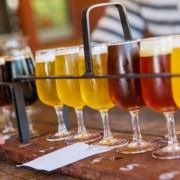What the Heck Is a Beer-Wine Hybrid?
A new drink hit the scene last year, beer-wine hybrids. I’m sure that this new beverage is going to be one of the hottest drink trends for 2014, but you may not have heard much about it because it premiered just before the fall and holiday rush. It’s not quite wine, and it’s not quite beer, but it’s not quite what you’d expect if you just poured some wine into a fresh, cold pint. The popularity and visibility of this new drink is increasing, and soon your guests will be asking you questions about it, questions that you, your sommeliers, and your cicerones should know the answers to.
Now that we’re in a brief lull between drinking holidays, you have the time to learn everything you need to know about beer-wine hybrids.
What is a beer-wine hybrid?
Beer-wine hybrids are just what they sound like: a mix of wine and beer in a single bottle. It’s usually made by combining wine grapes with the raw grain for beer, and then fermenting both together. Sometimes even the throw-away bits of wine, like leaves and stems (called the “must”), are combined with the wine grapes and raw grain, which creates a strong flavor. Sometimes the wine is indirectly mixed into the beer, by aging beer in well-used wine casks so that the beer inherits the flavors of the wine. However the beer-wine hybridization is done, in essence, this drink tastes and smells mostly like wine but has the texture of beer.
Who thought of that?
Beer and wine seem like an odd pairing, but actually, it turns out they were originally mixed together thousands of years ago in China and Egypt. Modern people discovered the idea when a University of Pennsylvania researcher, Patrick McGovern, dug up an ancient cask with weird, yellowish residue layered on the inside. He figured out that the residue was a blend of beer, wine, and mead, and he handed it off to Dogfish Head to figure out the recipe. Dogfish Head delivered, and modern man was able to enjoy the pleasures of his ancestors.
Who drinks this stuff anyway?
Okay, admittedly, beer-wine hybrids are not for everyone. They have a strange, musty flavor, and they are not a casual brew that you can just open up and enjoy at a barbecue. Mostly, this is a “beer” for wine people. Like wine, beer-wine hybrids must be savored and paid attention to… and that irks a lot of dedicated beer fans. One thing that you should definitely note is that even though this drink is designed to appeal to wine lovers, this is not something to offhandedly suggest for a beer lover. The flavor is just too strange, and you’ll end up with an unhappy customer.
How should I market it?
Since this blend appeals more to the wine market than the beer market, you’ll want to highlight it on wine lists specifically, but put it in a prominent area where adventurous beer drinkers will notice it as well. In liquor stores, this hybrid is bottled like a wine, and grouped with the wines—so it’s basically a gateway craft beer that seeks to win new converts. Once again, because beer-wine hybrids are more attractive to wine lovers, they are usually described like wine, so make sure to include descriptions of aromatics and complexity in your menu.
Whether or not you decide to include this new drink on your menu, you should certainly keep an eye on it. This blend will assuredly become a rising star in our fusion-driven food scene, and you’ll want to be the one place that offers it when customers decide they want to try it.
- Why Your Wine Menu Is Scaring Your Guests - February 27, 2015
- How to Host a Better Restaurant Week and Get More Customers - February 23, 2015
- Choosing Your Restaurant Wine Glass – 3 Approaches - February 16, 2015









